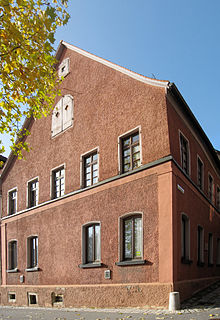 W
WBytom Synagogue or Beuthen Synagogue was a synagogue in Beuthen, in the Prussian Province of Silesia, a border–town between Germany and the Second Polish Republic prior to German invasion of Poland in World War II. After the plebiscite of 1922, the border passed just east of Beuthen, so that neighboring Katowice was in Poland.
 W
WThe Fasanenstrasse Synagogue was a liberal Jewish synagogue in Berlin, Germany opened on 26 August 1912. It was located in an affluent neighbourhood of Charlottenburg on Fasanenstrasse off Kurfürstendamm at numbers 79–80, close to the Berlin Stadtbahn and Zoo Station.
 W
WThe Synagogue in Glockengasse was a synagogue in Cologne built to the plans of the architect of the Cologne Cathedral, Ernst Friedrich Zwirner. It was built on the previous Monastery of St. Clarissa, where a modest hall of prayer had been erected in the years of the French occupation and had been closed in 1853 because it was unsafe.
 W
WThe Kassel Synagogue is the description given to a succession of prayer houses of the Jewish community in Kassel, Hesse.
 W
WKönigsberg's New Synagogue was one of three synagogues in Königsberg in Prussia, East Prussia. The other synagogues were Old Synagogue and Adass Jisroel synagogue. The New Synagogue was destroyed in the aftermath of Kristallnacht in 1938. It was reconstructed and reopened in 2018.
 W
WThe ornate Moorish Revival Leipzig Synagogue in Leipzig, Saxony, Germany, was built in 1855 by German Jewish architect Otto Simonson who had studied under Gottfried Semper, architect of the Semper Synagogue in Dresden.
 W
WNew Synagogue was a synagogue in Oppeln, Germany. It was built in 1893–1897, designed by Felix Henry. During the Kristallnacht on 9–10 November 1938 Nazis forced Rabbi Hans Hirschberg to set the building on fire.
 W
WNew Synagogue was a synagogue in Gleiwitz, Germany. It was built in 1859–1861, designed by Salomon Lubowski and Louis Troplowitz. The synagogue was destroyed by Nazis during the Kristallnacht on 9–10 November 1938.
 W
WThe New Synagogue was the largest synagogue in Breslau, Germany. It was one of the largest synagogues in the German Empire and a centre of Reform Judaism in Breslau. It was built in 1865–1872, and designed by Edwin Oppler. It was burnt down during the Kristallnacht pogrom which swept across Nazi Germany on 9–10 November 1938.
 W
WPrudnik Synagogue was a synagogue in Neustadt in Oberschlesien, Germany.
 W
WThe original Regensburg Synagogue, erected between 1210 and 1227, was an edifice in Old Romanesque style in Regensburg, southern Germany, on the site of the former Jewish hospital, in the center of the ghetto, where the present Neue Pfarre stands. Two etchings made by Albrecht Altdorfer of the synagogue shortly before it was destroyed on February 22, 1519, provide the first portrait of an actual architectural monument in European printmaking. In 1519 following the death of Emperor Maximilian, who had long been a protector of the Jews in the imperial cities, extracting from them substantial taxes in exchange, the city of Regensburg, which blamed its economic troubles on its prosperous Jewish community, expelled the 500 Jews. The Jews themselves had demolished the interior of their venerable synagogue, on the site of which a chapel was built in honor of the Virgin. According to a chronicle the exiles settled, under the protection of the Duke of Bavaria, on the opposite bank of the Danube, in Stadt-am-Hof, and in villages in the vicinity; from these they were expelled in the course of the same century.
 W
WRoonstrasse Synagogue, located in Cologne, Germany, is the only surviving of the five synagogues of the city before the Nazi era.
 W
WThe old Rottweil Synagogue is a synagogue in Rottweil in Baden-Württemberg. It was established in 1861. The desecrated Synagogue is located in Kameralamtsgasse 6, former Judengasse, close to Kapellenkirche and next to Bischöfliches Konvikt and gymnasium. The construction of a new synagogue in Rottweil began in March 2016.
 W
WThe Semper Synagogue, also known as the Dresden Synagogue, designed by Gottfried Semper and built from 1838 to 1840, was dedicated on 8 May 1840. It was an early example of the Moorish Revival style of synagogue architecture.
 W
WSpandau Synagogue was a synagogue at 12 Lindenufer in the Old Town area of Spandau, Berlin, Germany. It was also known as Spandauer Vereinssynagoge. The synagogue was built in 1894–95 and was destroyed on 9 November 1938 (Kristallnacht) when it was set on fire. The ruins were removed, probably in 1942. The site is now marked by a memorial tablet, installed in 1988. The congregation maintained a Jewish cemetery, on Spandau's Neue Bergstrasse, which was closed in 1940.
 W
WStolp Synagogue was a synagogue in Stolp, Germany. It was built in 1901–1902, designed by Eduard Koch. The synagogue was set on fire by Nazis during the Kristallnacht on 9–10 November 1938. In 2006 an unveiling ceremony was held for a monument commemorating the Jewish community of the city organized by the Foundation for the Preservation of Jewish Heritage in Poland.
 W
WThe Synagogue of Kłodzko was located in Kłodzko, in Kłodzko County in Lower Silesia, Poland. The synagogue was built 1884–1885 on the Grünestraße, now Wojska Polskiego Street, but was destroyed in 1938 during the Nazi Kristallnacht anti-Jewish pogrom.